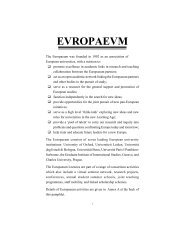to download a Special Report of this meeting - The Europaeum
to download a Special Report of this meeting - The Europaeum
to download a Special Report of this meeting - The Europaeum
Create successful ePaper yourself
Turn your PDF publications into a flip-book with our unique Google optimized e-Paper software.
Strategies and Balance<br />
kets, but we are beginning <strong>to</strong> focus on governance<br />
analytics more in our traditional credit<br />
rating process (what we call at S&P our own<br />
Enhanced Analytics Initiative). <strong>The</strong> question here<br />
is <strong>to</strong> what extent corporate governance should<br />
influence a credit rating positively or negatively.<br />
I would say it is more likely <strong>to</strong> be the case that if<br />
companies proceed with bad corporate governance,<br />
it is easier <strong>to</strong> for us <strong>to</strong> lower our credit<br />
rating. <strong>The</strong>re have not been any cases <strong>to</strong> date,<br />
and it may be a while before we see <strong>this</strong>, where<br />
we perceive good corporate governance actually<br />
raising a credit rating. This is something we<br />
need <strong>to</strong> think about..<br />
We also have an equity research group which<br />
fac<strong>to</strong>rs governance in<strong>to</strong> its equity assessments.<br />
Across S&P in our traditional analytical services,<br />
the cus<strong>to</strong>mers that we are serving – which are by<br />
and large from the institutional investment community<br />
– increasingly expect that we look at governance<br />
fac<strong>to</strong>rs rigorously and comprehensively,<br />
and that we assess the qualitative risks in a more<br />
systematic fashion than in the past.<br />
This takes us back <strong>to</strong> the theme here, which is<br />
the rule <strong>of</strong> codes, legislation, and codes <strong>of</strong> best<br />
practice. Obviously, in the light <strong>of</strong> many <strong>of</strong> the<br />
corporate governance problems that we have<br />
seen in recent years, there has been a whole flurry<br />
<strong>of</strong> public policy responses <strong>to</strong> try <strong>to</strong> address<br />
<strong>this</strong> from the <strong>to</strong>p down, <strong>to</strong> create codes, laws,<br />
regulations and what have you. I suppose, as we<br />
look at <strong>this</strong> thing, people may disagree with certain<br />
codes or certain types <strong>of</strong> legislation, but by<br />
and large I think <strong>this</strong> trend has been a positive<br />
development. In many ways it has raised the bar<br />
for corporate governance standards and practices.<br />
But at the same time I think we need <strong>to</strong> be<br />
very cautious. Regulations have their place, but<br />
they also have their limits, and the first point I<br />
would like <strong>to</strong> make is that we cannot simply<br />
assume that if a company can wave a piece <strong>of</strong><br />
paper that says they are compliant with<br />
Sarbanes-Oxley, the Combined Code or whatever<br />
else, <strong>this</strong> means that the company is well-governed<br />
and that we should sleep better at night.<br />
We need <strong>to</strong> look at compliance as a baseline, and<br />
not an end in itself. If we are not careful, compliance<br />
could be form without substance, and we all<br />
need <strong>to</strong> be alert <strong>to</strong> the risk <strong>of</strong> window-dressing<br />
and gaming the system, because any time you<br />
establish rules you are going <strong>to</strong> find people who<br />
will try <strong>to</strong> make it look good on the surface when<br />
there is rot within. Good corporate governance is<br />
not something that can be instituted simply by<br />
regula<strong>to</strong>ry fiat.<br />
This leads <strong>to</strong> the premise, and it is somewhat<br />
self-serving, but that is why we are devoting<br />
resources <strong>to</strong> it, that there is scope for a more<br />
market-based assessment. This is partly what<br />
Hermes and other institutional inves<strong>to</strong>rs are<br />
doing, but the point is that there is a limit <strong>to</strong> the<br />
positive impact <strong>of</strong> codes and hence a need for the<br />
market <strong>to</strong> assess governance risks in individual<br />
firms. If done properly – and it is a challenge <strong>to</strong><br />
do properly – <strong>this</strong> can compliment regula<strong>to</strong>ry<br />
initiatives. <strong>The</strong> process <strong>of</strong> evaluating governance<br />
can provide greater transparency for inves<strong>to</strong>rs as<br />
well as a positive incentive for companies <strong>to</strong><br />
improve governance standards. What is measured<br />
tends <strong>to</strong> be managed, and <strong>this</strong> can potentially<br />
create a virtuous cycle.<br />
It is really in that context that I would like <strong>to</strong><br />
put <strong>this</strong> discussion in the framework <strong>of</strong>, perhaps,<br />
an overly simplistic model. Think <strong>of</strong> corporate<br />
governance as a sort <strong>of</strong> combination <strong>of</strong> two basic<br />
things: one is corporate governance architecture,<br />
the types <strong>of</strong> things that tend <strong>to</strong> be codified in regulations<br />
in codes. <strong>The</strong> other part, which tends<br />
not <strong>to</strong> be focused upon because, frankly, it is<br />
more difficult <strong>to</strong> do, is the people<br />
who inhabitant <strong>this</strong> architecture.<br />
In many ways, I think <strong>this</strong><br />
dimension is missing from most<br />
analysis, although it is perhaps<br />
the most crucial dimension. If<br />
you imagine the “architecture”<br />
and “people” put in<strong>to</strong> a simple<br />
grid, in the best <strong>of</strong> all possible<br />
worlds, we would have good people<br />
in a good architecture and<br />
the opposite would be bad people<br />
in a bad architecture.<br />
I think the more interesting<br />
question comes when you look at<br />
the rest <strong>of</strong> the grid: would you<br />
rather have good architecture<br />
and bad people, or good people<br />
and bad architecture I think we<br />
would probably choose good<br />
21
















